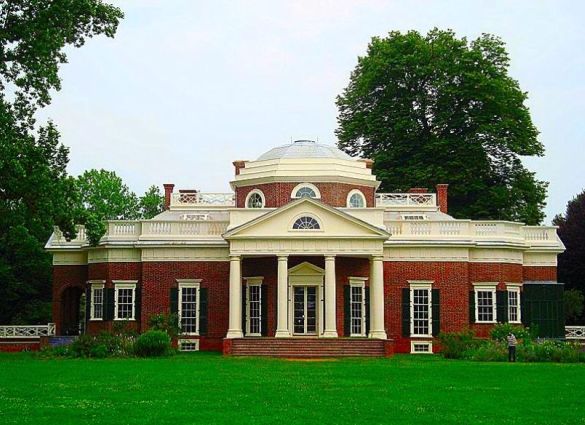
People often wonder aloud how a man who dedicated his life to liberty on the one hand could hold slaves close to him with the other, says Rex Ellis, an associate director with the Museum of African American History and Culture. The museum, which looks at American history from a black perspective, has created a new exhibition, housed at the Museum of American History, called "Slavery at Jefferson's Monticello: Paradox of Liberty."
"Throughout [Jefferson's] lifetime, he owned 607 enslaved men, women and children," says Ellis. "That paradox is what we hope to discuss, talk about and help visitors understand."
Just beyond the entrance to the exhibition, a large bronze statue of Jefferson stands before a backdrop of hundreds of names. These names, Ellis says, belong to almost every slave who worked and lived at Monticello.
As a short video on black life at Monticello plays in the background, Ellis walks past scores of artifacts made on the premises by six enslaved families. Farm tools, wooden barrels, furniture and other implements were crafted by the Gillettes, the Herns, the Fossetts, the Grangers, the Hubbards and the Hemingses. The Hemings family is perhaps the best known of the black Monticellans, because most historians now believe there is a high probability that Jefferson fathered at least one of Sally Hemings' children.
It's a point that still sparks heated dissent from a vocal minority, especially the Thomas Jefferson Heritage Society, which has been active in refuting the majority view. Indeed, the subject is so touchy, this exhibition might not have been possible even 20 years ago.

"Considering that there are those who have problems with this exhibition in 2012, I'd say that 15 years ago, it would have been pretty difficult to do something like this," says Ellis.
In the past two decades, he adds, interest in enslaved communities has grown by leaps and bounds — researchers are curious, and so are the descendants of slaves.
New Yorker Charles Shorter has come to the museum looking for his ancestors, who are descendants of the Hemings clan.
"This is really great," he says. "The family's been talking about the Shorters this and that, and I'm walking, and I say, 'God, I can't find anything!' And then I see Elizabeth Hemings, and I see her descendants and the ones who fought in the Civil War. And there is the picture of my great-great uncle and my great-grandfather."
Shorter says he possesses several family documents handed down from the first Charles Shorter, for whom he is named, that mention the Shorter-Hemings connection.
"The family gave it all to me," he says. "We didn't believe, though, that the Shorters were descended from the Hemings [family]. That was, you know, apocryphal. 'Isn't it nice? That's a great story.' And then we find out it's true."
"I'm bursting," Shorter adds, "because it validates everything that I had been told, and now it's been documented."

Peter Onuf, the Thomas Jefferson Foundation Professor of History at the University of Virginia, says the exhibition's emphasis on Jefferson's relationship to his slaves is an important addition.
"I'm not a Jefferson critic — obviously, I make a living doing Jefferson studies — but I think a balanced view of Jefferson is long overdue," Onuf says. "And I think we're ready to move on from the obsession with his sex life, to get over the shock and horror that he was a slave owner, and try to make sense of him in his own time and place."
Which is exactly what Rex Ellis is trying to do.
"We are looking at Jefferson, but, more importantly to me, we are somehow acknowledging the 600 men, women and children who also were a part of Jefferson's life," Ellis says.
Men, women and children who, in fact, made Jefferson's life possible — which, in turn, gave them a part in shaping early American history. (source: NPR)


nike trainers, abercrombie and fitch, michael kors, new balance pas cher, nike blazer, karen millen, north face, timberland, michael kors, sac louis vuitton, vans pas cher, converse pas cher, hollister, air max, air force, ralph lauren pas cher, ralph lauren, longchamp, longchamp, longchamps, mulberry, hogan outlet, hollister, louboutin, lululemon, ray ban pas cher, sac louis vuitton, nike free pas cher, air jordan, nike free, nike air max, hollister, nike roshe, michael kors, barbour, louis vuitton, vans shoes, vanessa bruno, hermes pas cher, sac guess, nike huarache, lacoste, montre homme, north face, louis vuitton uk, nike roshe run, oakley pas cher, ray ban sunglasses, tn pas cher, burberry
ReplyDelete